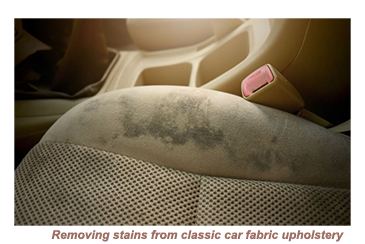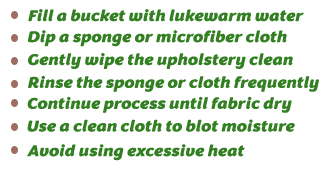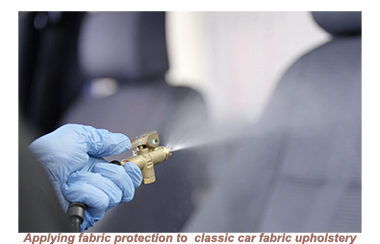
During the Fifties and Sixties in the UK and Wester Europe, most of the classic cars in the medium to upper class bracket had their seats and trimmings upholstered in fabric. Fabric upholstery had its advantages over its principal alternatives than its competition in the sector, being considerably less expensive than leather and much more pleasant to sit on than vinyl.
Its major downside was the propensity of fabric to stain, soil and rip. Those owners of restored classics who continued the theme with fabric upholstery must be prepared to pay the same price today.
![]()
To maintain the hygiene and appearance of fabric upholstery, it is recommended to perform a comprehensive cleaning process that eliminates any accumulated dirt, grime, and stains. It is important to choose an appropriate upholstery cleaner compatible with the specific type of fabric or leather being cleaned, taking particular care to adhere to the instructions provided by the manufacturer and handle the item with care to prevent any potential damage.
![]() Address any spills or stains on the upholstery promptly to prevent them from setting in. Blot the affected area with a clean, absorbent cloth or paper towel to soak up as much of the spill as possible. Then, use a mild upholstery cleaner or fabric spot remover suitable for the type of fabric in the car. Test the cleaner on a small, inconspicuous area first to ensure it doesn't cause discoloration or damage.
Address any spills or stains on the upholstery promptly to prevent them from setting in. Blot the affected area with a clean, absorbent cloth or paper towel to soak up as much of the spill as possible. Then, use a mild upholstery cleaner or fabric spot remover suitable for the type of fabric in the car. Test the cleaner on a small, inconspicuous area first to ensure it doesn't cause discoloration or damage.
.
![]()
 such as rips, tears, or holes , utilising a fabric or leather repair kit is recommended for the best results.
such as rips, tears, or holes , utilising a fabric or leather repair kit is recommended for the best results.
Typically, these kits are equipped with patches, adhesive, and detailed instructions on the proper application process.
 To acheive optimal outcomes, it is recommended to adhere closely to the guidelines provided. In case of significant damage to the upholstery, it is advisable to seek the assistance of a professional or an experienced upholsterer.
To acheive optimal outcomes, it is recommended to adhere closely to the guidelines provided. In case of significant damage to the upholstery, it is advisable to seek the assistance of a professional or an experienced upholsterer.
![]() Over time, foam padding is prone to degradation and deformation over time, which can lead to the development of droopy or uncomfortable seating arrangements. As a result, it may be necessary to replace the foam padding. In case of any damage or compression in the foam, it is advisable to replace it with new padding.
Over time, foam padding is prone to degradation and deformation over time, which can lead to the development of droopy or uncomfortable seating arrangements. As a result, it may be necessary to replace the foam padding. In case of any damage or compression in the foam, it is advisable to replace it with new padding.
To replace foam pieces, it is important to measure and cut them to match the size and shape of the original ones accurately. It is important to ensure that the foam being used is of the appropriate density and thickness to provide the best possible level of comfort.
![]() A steam cleaner is a very powerful tool- having access to one is a considerable advantage especially for cleaning all forms of upholstered surfaces.
A steam cleaner is a very powerful tool- having access to one is a considerable advantage especially for cleaning all forms of upholstered surfaces.
 A steam cleaner operates through using high-pressure steam to clean and sanitize surfaces. The steam is generated by heating water to a high temperature, and then forcing it through a nozzle. The heat and pressure of the steam help to loosen dirt and grime, making it easy to wipe away.
A steam cleaner operates through using high-pressure steam to clean and sanitize surfaces. The steam is generated by heating water to a high temperature, and then forcing it through a nozzle. The heat and pressure of the steam help to loosen dirt and grime, making it easy to wipe away.
When using a steam cleaner on the interior of a classic car, the first stage is the to vacuum the upholstery to remove any loose dirt and debris.
Using the steam cleaner, clean the seats and other fabric or leather surfaces by directing the steam onto the surface and scrubbing gently with a brush or cloth. The heat and pressure of the steam will help to loosen dirt and stains, making them easier to remove.
Considerable care and attention is demanded when using a steam cleaner on classic car upholstery, as the heat and pressure of the steam can cause damage to delicate materials.
To minimise the risk of damage the steam cleaner should be tried out on a small, inconspicuous area before cleaning the entire car,paying extra attention to avoid any areas that are prone to get too hot -such as the dashboard and gauges.
![]()
![]() Begin by vacuuming the fabric upholstery regularly to remove loose dirt, dust, and debris. Use a soft brush attachment or a vacuum cleaner specifically designed for upholstery to gently clean the fabric. Pay special attention to crevices and hard-to-reach areas.
Begin by vacuuming the fabric upholstery regularly to remove loose dirt, dust, and debris. Use a soft brush attachment or a vacuum cleaner specifically designed for upholstery to gently clean the fabric. Pay special attention to crevices and hard-to-reach areas.
![]()


![]()
 To provide additional protection to fabric upholstery a fabric protectant or sealant can be applied. The role of the protectant is to create a barrier against spills and stains.
To provide additional protection to fabric upholstery a fabric protectant or sealant can be applied. The role of the protectant is to create a barrier against spills and stains.
![]() Protect the fabric upholstery from prolonged exposure to direct sunlight, as it can cause fading and deterioration over time. Park the classic car in shaded areas whenever possible, and use sunshades or window tinting to block UV rays. If parking indoors is an option, it can provide additional protection from sunlight.
Protect the fabric upholstery from prolonged exposure to direct sunlight, as it can cause fading and deterioration over time. Park the classic car in shaded areas whenever possible, and use sunshades or window tinting to block UV rays. If parking indoors is an option, it can provide additional protection from sunlight.
![]() Be mindful of sharp objects such as keys, belt buckles, or other potentially damaging items that can scratch or tear the fabric upholstery. Take care when entering and exiting the car to prevent unnecessary damage.
Be mindful of sharp objects such as keys, belt buckles, or other potentially damaging items that can scratch or tear the fabric upholstery. Take care when entering and exiting the car to prevent unnecessary damage.
 In every instance the manufacturer's recommendations should be adhered to . For additional guidance it is always advisable to consult with classic car restoration experts for any specific care instructions or considerations for the classic car's fabric upholstery.
In every instance the manufacturer's recommendations should be adhered to . For additional guidance it is always advisable to consult with classic car restoration experts for any specific care instructions or considerations for the classic car's fabric upholstery.
Taking proper care of a classic car's fabric upholstery will help maintain appearance and ensure that it remains in excellent condition for years to come.





